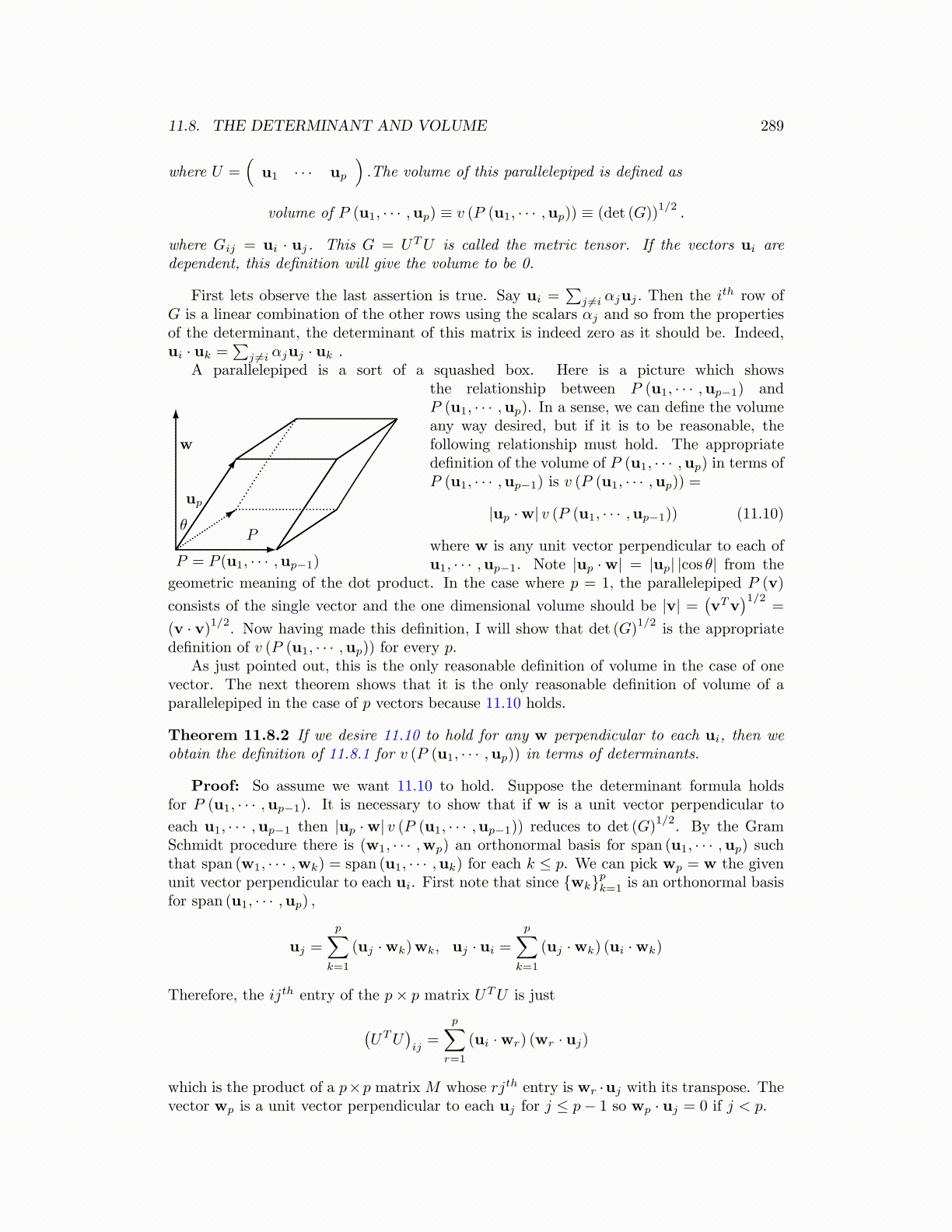
11.8. THE DETERMINANT AND VOLUME 289
where U =(
u1 · · · up
).The volume of this parallelepiped is defined as
volume of P (u1, · · · ,up) ≡ v (P (u1, · · · ,up)) ≡ (det (G))1/2
.
where Gij = ui · uj. This G = UTU is called the metric tensor. If the vectors ui aredependent, this definition will give the volume to be 0.
First lets observe the last assertion is true. Say ui =∑
j ̸=i αjuj . Then the ith row ofG is a linear combination of the other rows using the scalars αj and so from the propertiesof the determinant, the determinant of this matrix is indeed zero as it should be. Indeed,ui · uk =
∑j ̸=i αjuj · uk .
A parallelepiped is a sort of a squashed box. Here is a picture which shows
P
up
w
θ
P = P (u1, · · · ,up−1)
the relationship between P (u1, · · · ,up−1) andP (u1, · · · ,up). In a sense, we can define the volumeany way desired, but if it is to be reasonable, thefollowing relationship must hold. The appropriatedefinition of the volume of P (u1, · · · ,up) in terms ofP (u1, · · · ,up−1) is v (P (u1, · · · ,up)) =
|up ·w| v (P (u1, · · · ,up−1)) (11.10)
where w is any unit vector perpendicular to each ofu1, · · · ,up−1. Note |up ·w| = |up| |cos θ| from the
geometric meaning of the dot product. In the case where p = 1, the parallelepiped P (v)
consists of the single vector and the one dimensional volume should be |v| =(vTv
)1/2=
(v · v)1/2. Now having made this definition, I will show that det (G)1/2
is the appropriatedefinition of v (P (u1, · · · ,up)) for every p.
As just pointed out, this is the only reasonable definition of volume in the case of onevector. The next theorem shows that it is the only reasonable definition of volume of aparallelepiped in the case of p vectors because 11.10 holds.
Theorem 11.8.2 If we desire 11.10 to hold for any w perpendicular to each ui, then weobtain the definition of 11.8.1 for v (P (u1, · · · ,up)) in terms of determinants.
Proof: So assume we want 11.10 to hold. Suppose the determinant formula holdsfor P (u1, · · · ,up−1). It is necessary to show that if w is a unit vector perpendicular to
each u1, · · · ,up−1 then |up ·w| v (P (u1, · · · ,up−1)) reduces to det (G)1/2
. By the GramSchmidt procedure there is (w1, · · · ,wp) an orthonormal basis for span (u1, · · · ,up) suchthat span (w1, · · · ,wk) = span (u1, · · · ,uk) for each k ≤ p. We can pick wp = w the givenunit vector perpendicular to each ui. First note that since {wk}pk=1 is an orthonormal basisfor span (u1, · · · ,up) ,
uj =
p∑k=1
(uj ·wk)wk, uj · ui =
p∑k=1
(uj ·wk) (ui ·wk)
Therefore, the ijth entry of the p× p matrix UTU is just
(UTU
)ij=
p∑r=1
(ui ·wr) (wr · uj)
which is the product of a p×p matrixM whose rjth entry is wr ·uj with its transpose. Thevector wp is a unit vector perpendicular to each uj for j ≤ p− 1 so wp · uj = 0 if j < p.